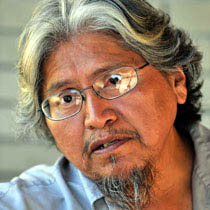
17 August 2008
Half-Completed Tunnels Tell of Chinese Hardship
| |

Sonny McHalsie of the Sto:lo Nation led a railway tunnel
tour.
|
Hope British Columbia - For many years, the elders of the
Sto:lo Nation have whispered about the ghosts that linger around the half-completed mountain railway tunnels west of Hope.
The legend says unmarked graves nearby contain the remains of Chinese men, Canadian Pacific Railway labourers forced in the 1880s to
enter the makeshift tunnels to light the dynamite that would blast through the rock.
"When a tragic death happens, the elders talk about the spirit staying behind," said Sonny McHalsie, cultural adviser at the
Sto:lo Nation office. "They would say the ghosts of Chinese workers were still there."
 McHalsie and Chinese-Canadian activist Bill Chu led a tour of the half-completed tunnels on Thursday, hoping
to raise public awareness of Chinese history during Chinese Heritage Week.
McHalsie and Chinese-Canadian activist Bill Chu led a tour of the half-completed tunnels on Thursday, hoping
to raise public awareness of Chinese history during Chinese Heritage Week.
"It's incumbent on the Chinese community to do something," said Chu, an organizer with Canadians for Reconciliation, a group
devoted to fostering peaceful relationships with B.C.'s first nations people.
Chu has been organizing events and tours to help educate B.C.'s Chinese-Canadian people about aboriginal people and their
communities.
The tunnels, half-completed but abandoned after too many workers were killed during blasting, stand six km west of Hope,
on the north side of the Fraser River.
In the 1880s, when more than 10,000 Chinese workers came to B.C. to build the Canadian Pacific Railway, the Chinese were used for their
work ethic, but were often perceived by Caucasian labourers as less than worthy colleagues.
If the thousands of Chinese labourers who died didn't perish in the tunnels, they fell victim to malnutrition, scurvy, and from lack of
access to medical treatment when they were injured or sick, Chu said.
"We're not talking about avoidable accidents," he said. "We're talking about discrimination, and the attitude that the
Chinese were not human beings."
Chinese CPR labourers were not only ill-prepared for Fraser Valley winters, their wages were far below those of Caucasian
workers - a point that placed them in direct conflict with their colleagues and exacerbated the discrimination against them.
A month's salary of $25 would have to cover a Chinese worker's debt to the steamboat company, clothes, a room rental, tools, and fares.
It was in that era that the racist phrase, a "Chinaman's chance" was coined. It referred to the possibility that a Chinese
member of a railway crew blasting tunnels for the CPR line would come out of it alive. "A Chinaman's chance was a derogatory
phrase meaning no luck," said Chu.
The area surrounding the tunnels is a physical testament to the rugged environment the Sto:lo Nation shared with the labourers, said
McHalsie, who has worked with researchers on local first nations history from the University of B.C., Simon Fraser University, and the
University of California at Los Angeles.
Just last week, a UCLA researcher found an antique Chinese coin sitting on the edge of a Sto:lo subterranean dwelling. No dig was
needed: the piece was found in plain sight.
Much like first nations history, the history of Chinese labourers in B.C. must be re-appropriated and rewritten, Chu said.
"A history that is written by somebody else would not reflect what really transpired. It's up to us to write our own history. It
would help British Columbia to move forward."
|